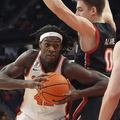‘Peppy Downer’ exhibit shows ‘window into the world’ with zany photographs

Light Work's "Peppy Downer" exhibit showcases work from photographers like David Broda and Jon Reis. Broda's photos highlight subtle humor, while Reis captures moments that stand out as unusual and different in events with large crowds. Ella Chan | Asst. Photo Editor
Get the latest Syracuse news delivered right to your inbox.
Subscribe to our newsletter here.
David Broda spent six months after his college graduation traveling around the country with friends, taking photos during what he would describe as “the golden age of modern photography” in the late 1960s and early 1970s.
Around this same time in the 1970s, Jon Reis settled in Ithaca and began exploring central New York, capturing the spirit of the area through his lens and crafting what he described as “social documentaries.” Also a licensed pilot, Reis brought an in-depth perspective by photographing the region from both the sky and the ground.
“Everything I did, I had my camera with me,” Reis said. “My love of flying has yielded lots of photos.”
Both artists are featured in the “Peppy Downer” exhibit, which is on display in Light Work until April 25. This exhibit was curated by photographer Lucas Blalock, who came to Light Work after previously curating an exhibit with Whitney Hubbs, Light Work’s associate director, in New York City.
“There are a lot of ideas in photography that I love that don’t necessarily fit into the work that I make,” Blalock said. “Curating and writing and doing these other kinds of things as a way to be involved in those other worlds.”
Blalock said the path to becoming a photographer is a long journey, but his passion for photography continues to be driven by how it’s an everyday language. He finds excitement in working with a medium that’s universally used, and therefore easily understood by viewers.
Broda graduated from Syracuse University’s S.I. Newhouse School of Public Communications in 1974 with a dual major in photojournalism and psychology. After his travels and living in California, he came back to Syracuse and got a job as the university photographer, where he helped students develop portfolios, printed exhibitions from Bird Library’s photography collection and more.
His interest in photography came from his uncle, who was also a photographer. Broda’s uncle had a darkroom in the basement of his grandma’s house in Niagara Falls. He typically kept the room locked so Broda, who was 5 years old at the time, couldn’t get in.
“It was always a very mysterious place, and every now and then we’d go down there and he would unlock the door and he’d let us into the darkroom,” Broda said. “It’s magical, as a kid, so that’s sort of what got the juices flowing.”
Broda has since switched to digital photography, but is interested to see how film is circling back today.

In Light Work’s “Peppy Downer” photography exhibit, works from photographers like David Broda and Jon Reis reveal everyday scenes with a little humor. The two photographers started their work around the same time in the late 1960s and early to mid 1970s. Ella Chan | Assistant Photo Editor
Blalock describes the “Peppy Downer” exhibit as a mirror to our times.
“It’s a reflection of the moments now, but they are also windows onto the world,” Blalock said. “Each one looks out and they also reflect back.”
One piece that speaks to this theme is Reis’ photo “Kodak Kids,” taken at the 1978 Orange Bowl Parade in Miami Beach, Florida. Reis was looking for something to do while visiting his parents and ended up at the annual New Year’s Eve celebration in Miami Beach. It was there he stumbled upon a group of four cheerleaders, each with a camera in hand. Intrigued by the moment, he asked if he could take their picture, and one girl simultaneously snapped a photo of him.
Early in Reis’ career, he was drawn to events with large crowds, capturing moments that stood out as unusual or different in a style known as “social photography.” He found opportunities in places like football games, where he noted the halftime show provided just as interesting an opportunity as the game itself.
He was inspired by famous street photographers, like Lee Friedlander, Garry Winogrand and Danny Lyon. He was lucky enough to study with and learn from them through workshops.
Reis developed important skills during these workshops that he carried with him through his career. His recent work reflects his roots as a pilot, as he now travels to airports in various cities where he captures the scenes there. He also runs a portrait studio in Ithaca.
“Every day was a day of going out and shooting with the main photographer and then processing the film and then in the evening making prints and then showing them,” Reis said.
Blalock mentioned that “Peppy Downer” features many pieces that capture out-of-the-ordinary ideas. He said that he has always found absurdity, and the humor that comes with it, very exciting.
Subtle humor is a large part of Broda’s work and is highlighted in a few of his six photos featured in the exhibit. One of these is an untitled piece from 1983 that shows a wooden barrel in a waterfall. The photo actually depicts a backdrop at Niagara Falls where tourists could pose inside a barrel as if they were falling over the edge of the waterfall.
In the early 1900s, daredevils used to test the limits by climbing into barrels and other objects and launching themselves over the falls to become famous. Broda said the photo references the commercialization of tourism, especially at the falls.
Blalock created this exhibit with his own ideas and story in mind, but he hopes the photos speak to viewers’ lives. He pointed out that while people often glance quickly at images these days, he hopes they take the time to absorb and reflect on the photos in “Peppy Downer.”
“There’s more to unpack if you stay with them for a little while,” Blalock said.






